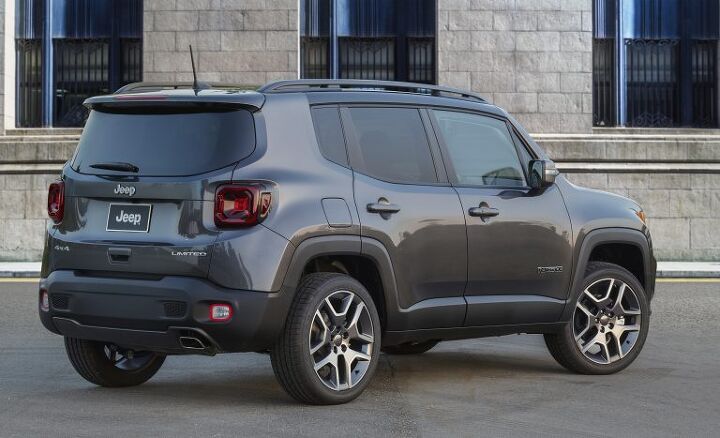Jeep Renegade Plug-in Promises to Conquer Nature the Socially Acceptable Way

There’s a raft of changes coming to Jeep’s Renegade for the 2019 model year, but the brand’s run-down of the various alterations for the U.S. market didn’t include the possibility of a gas-electric variant. That’s what’s coming to the model, however, as Fiat Chrysler looks to ditch its overseas diesel powerplants by 2021 and curry favor with green governments (and buyers).
On Monday, Jeep announced it had begun preparations for the production of a plug-in hybrid variant of its smallest model.
This should come as no surprise, as the automaker announced eight plug-in hybrid Jeep models for the American market during the June unveiling of its five-year plan. Globally, Jeep’s lineup is expected to gain 10 hybrids and four fully-electric vehicles by 2022. Backing the automaker’s company-wide electrification plan is over $10 billion in development cash.
Given former CEO Sergio Marchionne’s ambitions for the Jeep brand, no model in the brand’s lineup will remain untouched by electricity. While growth in Europe and China remains top of mind, the U.S. market isn’t exactly the most unregulated jurisdiction. A Wrangler PHEV is already in development.
One of the main benefits to rough-and-tumble Jeep purists of this setup, fuel bills aside, is the instant, measured, and strong torque made available by an electric motor, which could come in handy while rock crawling. Hunters might like the ability to arrive in the woods in relative silence, depending on forest floor material.
For 2019, the Italy-built Renegade gains an uplevel 1.3-liter turbocharged four-cylinder, good for 177 horsepower and 200 lb-ft of torque. The 2.4-liter Tigershark motor remains in the Renegade fold. No details exist on what kind of range to expect from the plug-in.
So, when can we expect a PHEV model? FCA claims the hybridized Renegade should launch in Europe in early 2020, though we’re almost certain to see it arrive here not long after.
[Image: Fiat Chrysler Automobiles]

More by Steph Willems
Latest Car Reviews
Read moreLatest Product Reviews
Read moreRecent Comments
- Kwik_Shift_Pro4X '19 Nissan Frontier @78000 miles has been oil changes ( eng/ diffs/ tranny/ transfer). Still on original brakes and second set of tires.
- ChristianWimmer I have a 2018 Mercedes A250 with almost 80,000 km on the clock and a vintage ‘89 Mercedes 500SL R129 with almost 300,000 km.The A250 has had zero issues but the yearly servicing costs are typically expensive from this brand - as expected. Basic yearly service costs around 400 Euros whereas a more comprehensive servicing with new brake pads, spark plugs plus TÜV etc. is in the 1000+ Euro region.The 500SL servicing costs were expensive when it was serviced at a Benz dealer, but they won’t touch this classic anymore. I have it serviced by a mechanic from another Benz dealership who also owns an R129 300SL-24 and he’ll do basic maintenance on it for a mere 150 Euros. I only drive the 500SL about 2000 km a year so running costs are low although the fuel costs are insane here. The 500SL has had two previous owners with full service history. It’s been a reliable car according to the records. The roof folding mechanism needs so adjusting and oiling from time to time but that’s normal.
- Theflyersfan I wonder how many people recalled these after watching EuroCrash. There's someone one street over that has a similar yellow one of these, and you can tell he loves that car. It was just a tough sell - too expensive, way too heavy, zero passenger space, limited cargo bed, but for a chunk of the population, looked awesome. This was always meant to be a one and done car. Hopefully some are still running 20 years from now so we have a "remember when?" moment with them.
- Lorenzo A friend bought one of these new. Six months later he traded it in for a Chrysler PT Cruiser. He already had a 1998 Corvette, so I thought he just wanted more passenger space. It turned out someone broke into the SSR and stole $1500 of tools, without even breaking the lock. He figured nobody breaks into a PT Cruiser, but he had a custom trunk lock installed.
- Jeff Not bad just oil changes and tire rotations. Most of the recalls on my Maverick have been fixed with programming. Did have to buy 1 new tire for my Maverick got a nail in the sidewall.



































Comments
Join the conversation
It's good to see the hybridization of "normal" vehicles; not just the ones people use for virtue signaling.
The Renegade is tiny. Itty-bitty. Made for narrow Old World roads. Where the hell would they strap enough battery capacity to be useful? The Mitsubishi Outlander PHEV coughs up only 22 electric miles and it has a much longer undercarriage, and no mechanical connection to the rear drive wheels to get in the way (rear wheels electric only, front wheels able to cycle from gas, electric, or gas-electric hybrid). This smells like another European short-range bad-faith fake PHEV that kicks on the gas engine at the faintest whiff of throttle and can't go more than 14 miles on a charge, but rather exists only to allow urban drivers (who really need an SUV for those cobblestones, don't you know) to evade congestion or pollution charges for entering the city center by saying they will do so in "electric mode."